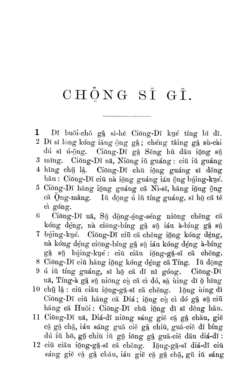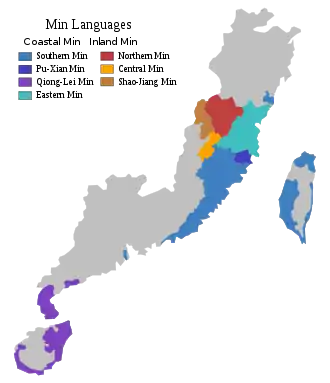Jian'ou dialect
Jian'ou dialect (Northern Min: Gṳ̿ing-é-dī / 建甌事; Chinese: simplified Chinese: 建瓯话; traditional Chinese: 建甌話; pinyin: Jiàn'ōu huà), also known as Kienow dialect, is a local dialect of Northern Min Chinese spoken in Jian'ou in northern Fujian province. It is regarded as the standard common language in Jian'ou.
| Jian'ou | |
|---|---|
| Gṳ̿ing-é-dī / 建甌事 | |
| Pronunciation | [kuiŋ˧ ɪ˥˦ ti˦] |
| Native to | Southern China |
| Region | Jian'ou, Fujian province |
| Chinese character, Kienning Colloquial Romanized | |
| Language codes | |
| ISO 639-3 | – |
| Glottolog | jian1240 |

Phonetics and phonology
According to The Eight Tones of Kien-chou (建州八音), a rime dictionary which published in 1795, Jian'ou dialect has 15 initials, 34 rimes and 7 tones in the 18th century, however there are only 6 tones in the modern dialect as the "light level" (陽平) tone disappeared.
Initials
| Bilabial | Alveolar | Velar | Glottal | ||
|---|---|---|---|---|---|
| Nasal | m | n | ŋ | ||
| Plosive | voiceless unaspirated | p | t | k | ʔ |
| voiceless aspirated | pʰ | tʰ | kʰ | ||
| Affricate | voiceless unaspirated | ts | |||
| voiceless aspirated | tsʰ | ||||
| Fricative | s | x | |||
| Approximant | l | ||||
Rimes
| Open syllable | Nasal coda | |||||||||||||||
|---|---|---|---|---|---|---|---|---|---|---|---|---|---|---|---|---|
| Open mouth | a | ɪ | ɛ | œ | ʊ | ɔ | ai | au | aŋ | aiŋ | eiŋ | œyŋ | ɔŋ [1] | |||
| Even mouth | i | ia | iɛ | iɔ | iau | iu | iŋ | iaŋ | ieiŋ[2] | iɔŋ | ||||||
| Closed mouth | u | ua | uɛ [3] | uai | uiŋ [4] | uaŋ | uaiŋ | uɔŋ | ||||||||
| Round mouth | y | yɛ [3] | yiŋ [4] | |||||||||||||
Tones
Jian'ou has four tones, which are reduced to two in checked syllables.
| Tone number | Tone name | Tone contour |
|---|---|---|
| 1 | level (平聲) | ˥˦ (54) or ˥ (5) |
| 2 | rising (上聲) | ˨˩ (21) or ˩ (1) |
| 3 | dark departing (陰去) | ˨ (2) |
| 4 | light departing (陽去) | ˦ (4) |
| 5 | dark entering (陰入) | ˨˦ (24) |
| 6 | light entering (陽入) | ˦˨ (42) |
The entering tones in Jian'ou dialect do not have any entering tone coda (入聲韻尾) such as /-ʔ/, /-p̚/, /-t̚/ and /-k̚/ which makes it distinct from many other Chinese varieties.
Footnotes
- /oŋ/ which is mentioned in Kienning Colloquial Romanized has merged into /ɔŋ/ in the modern dialect.
- /ieiŋ/ is not mentioned in Kienning Colloquial Romanized as it diverged from /iŋ/ after the romanization system was established.
- /yɛ/ tends to merge into /uɛ/.
- /yiŋ/ tends to merge into /uiŋ/.
References
- Běijīng dàxué zhōngguóyǔyánwénxuéxì yǔyánxué jiàoyánshì. (1989) Hànyǔ fāngyīn zìhuì. Běijīng: Wénzìgǎigé chūbǎnshè.(北京大學中國語言文學系語言學教研室. 1989. 漢語方音字匯. 北京: 文字改革出版社)
- Norman, Jerry. [1988] (2002). Chinese. Cambridge, England: CUP ISBN 0-521-29653-6
- Yuán, jiāhuá (1989). Hànyǔ fāngyán gàiyào (An introduction to Chinese dialects). Beijing, China: Wénzì gǎigé chūbǎnshè. (袁家驊. 1989. 漢語方言概要. 北京:文字改革出版社.)
- Compilation Commission of Chorography of Jian'ou County 建瓯县地方志编纂委员会 (1994). Jian ou xian zhi 建瓯县志 ["Chorography of Jian'ou County"]. 36. Beijing: Zhonghua Book Company. ISBN 7-101-01283-3.
External links
- Lien, Chinfa (1990). "Competing final systems in the Jian'ou dialect" (PDF). Tsing Hua Journal of Chinese Studies. 20 (1): 1–53.
- Cantonese and other dialects (in Chinese)
- Classification of Northern Min Dialects from Glossika
- Jian'ou Romanized Vernacular Bible
